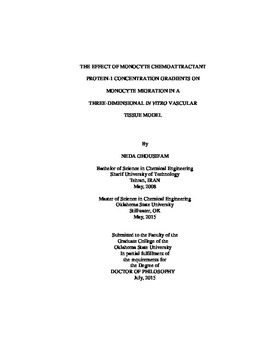| dc.contributor.advisor | Gappa-Fahlenkamp, Heather | |
| dc.contributor.author | Ghousifam, Neda | |
| dc.date.accessioned | 2016-09-29T18:40:13Z | |
| dc.date.available | 2016-09-29T18:40:13Z | |
| dc.date.issued | 2015-07 | |
| dc.identifier.uri | https://hdl.handle.net/11244/45259 | |
| dc.description.abstract | The initiation of atherosclerosis is marked by the accumulation of lipid substances in the subendothelial layer of major arteries, followed by adhesion and transmigration of monocytes to the extracellular matrix (ECM). Cellular adhesion molecules (CAMs) and chemokines participate in the transmigration of monocytes during the formation of atherosclerotic lesions. Monocyte chemoattractant protein-1 (MCP-1) direct monocytes to the site of inflammation by forming concentration gradients within the ECM. Many studies use two-dimensional (2D) cell culture models to study monocytes migration; however, these models lack the ECM to investigate the formation of MCP-1 gradients within the matrix. In this work, an advanced three-dimensional (3D) in vitro vascular tissue model was introduced as a novel tool to study the mechanisms occurring within the ECM that drive monocytes migration. The 3D model consists of human aortic endothelial cells (HAEC) grown on a collagen matrix to better mimic the human artery and surrounding ECM. The main objective of this study was to determine the effect of MCP-1 local concentration gradients within the ECM on monocytes migration. To meet the objective, the 3D tissue model was compared to a 2D model that lacks a matrix and free MCP-1 is diluted in the surrounding medium. Experimental results showed that HAEC on the 2D models had significantly higher CAMs expression than the 3D models after 24 h stimulation. There was no significant difference in MCP-1 expression between models. A greater number of monocytes transmigrated across the endothelium in the 3D tissue model compared to the 2D model. A mathematical model was derived to estimate MCP-1 concentrations within the 3D model at various time points and locations within the matrix. The mathematical model indicates that concentration gradients of both free and bound MCP-1 are formed inside the collagen matrix, and the concentration of bound MCP-1 surpasses the free MCP-1 after 12 h. The results of this research have provided new information regarding the relationship between MCP-1 concentration gradients and monocytes transendothelial migration, due to the effect of haptotactic gradients. The 3D tissue model can also be used to study cellular mechanisms associated with other types of chronic inflammatory diseases. | |
| dc.format | application/pdf | |
| dc.language | en_US | |
| dc.rights | Copyright is held by the author who has granted the Oklahoma State University Library the non-exclusive right to share this material in its institutional repository. Contact Digital Library Services at lib-dls@okstate.edu or 405-744-9161 for the permission policy on the use, reproduction or distribution of this material. | |
| dc.title | Effect of monocyte chemoattractant protein-1 concentration gradients on monocyte migration in a three-dimensional in vitro vascular tissue model | |
| dc.contributor.committeeMember | Madihally, Sundararajan V. | |
| dc.contributor.committeeMember | Ramsey, Joshua D. | |
| dc.contributor.committeeMember | Krishnan, Sadagopan | |
| osu.filename | Ghousifam_okstate_0664D_14241.pdf | |
| osu.accesstype | Open Access | |
| dc.type.genre | Dissertation | |
| dc.type.material | Text | |
| thesis.degree.discipline | Chemical Engineering | |
| thesis.degree.grantor | Oklahoma State University | |
